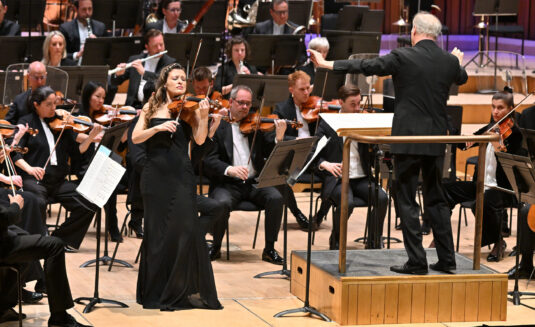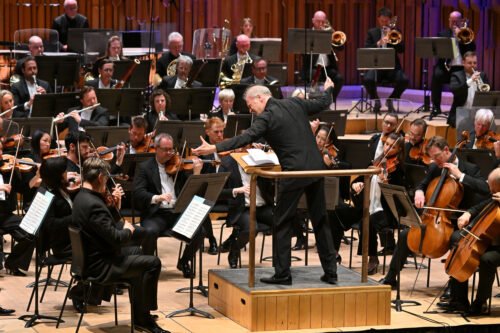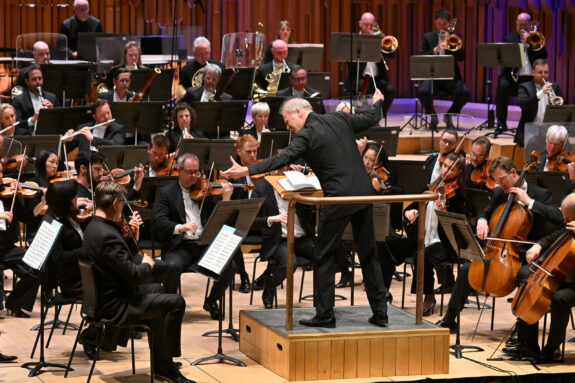 United Kingdom Shostakovich, MacMillan: Nicola Benedetti (violin), London Symphony Orchestra, Gianandrea Noseda (conductor), Barbican Hall, London, 3.4.2025. (MBr)
United Kingdom Shostakovich, MacMillan: Nicola Benedetti (violin), London Symphony Orchestra, Gianandrea Noseda (conductor), Barbican Hall, London, 3.4.2025. (MBr)

Shostakovich – Festive Overture; Symphony No.12, ‘The Year 1917’
MacMillan – Violin Concerto No.2
Shostakovich had been considering writing a Lenin symphony since the late 1930s but he never actually composed one until 1960/61. That symphony – the Twelfth – emerging from a period of dark despair and personal crisis, has long been considered one of Shostakovich’s worst. I am not going to argue that it isn’t, but it does need some convincing advocacy from a conductor to turn it into something almost rather better than it is and with Gianandrea Noseda and the London Symphony Orchestra on electrifying form we got precisely that.
Perhaps this is not surprising since the Twelfth does have an odd kind of ‘British’ history having been premiered in the West at the Edinburgh Festival by the Philharmonia Orchestra and then given its first by a Western conductor (Sir Adrian Boult with the BBC Symphony Orchestra). But is this most ‘communist’ of Shostakovich’s symphonies all that it seems? It is, for one, his most traditional work, his only symphony that truly follows the nineteenth-century symphonic format. Yoked to this is a rather cinematic portrait of revolutionary 1917 that never quite achieves its aims: the disconnect between the titles Shostakovich gives each movement and the music is never quite clear. Perhaps another problem is that Twelfth is full of quotes from earlier symphonies – fragments of the Stalinist Allegro of the Tenth, the finale of the Fourth, and the final pages of the Fifth to name a few – that the work can seem short on the subject which was to inspire it.

Having said this, the symphony is not a dull one to listen to assuming the conductor has a connection with the work which Noseda clearly did. One couldn’t, for example, have asked for a first movement – ‘Revolutionary Petrograd’ – where the tempos were so explicitly right, where we got a Moderato and an Allegro in absolutely perfect proportion to one another, and where the turmoil of the development was so exactly as it should be either. Likewise, ‘Razliv’ (Lenin’s hideout), the slow movement of the work, was gorgeously phrased – darkly hued and owing everything to Mussorgsky who surely inspired the music of the movement. There were superb things here: a lamenting solo clarinet, brooding cellos, the bleak tones of a bassoon. It is not the deepest picture of Lenin but Noseda lavished more care on instrumental solos than many conductors I have heard in this score.
‘Aurora’, the scherzo of the work, is short, but packed a punch. That huge crescendo from pp to fff on the percussion was a thrilling shot from the gunboat it is there to represent, tam-tam and drumrolls terrifying in all their cinematic horror. The final movement, ‘The Dawn of Humanity’ hardly seems unambiguous in its musical quotations, and yet hardly seems relevant either to its Leninist inspiration. Noseda brought impressive conviction to this music, when it is often considerably less than that, and the LSO were exceptional in playing that moved from the ominous to the bombastic.
It might be a pity if LSO Live (who were recording the symphony for their complete Shostakovich cycle with Noseda) missed out on including the opening work, the composer’s Festive Overture. Written to celebrate the thirtieth anniversary of the October 1917 Revolution, this short work with its brass fanfares was given an exuberant and thrilling performance.
Nicola Benedetti was the soloist in James MacMillan’s Violin Concerto No.2. Dedicated to her, but in memoriam to Krzysztof Penderecki, I felt this concerto seemed to take more inspiration from Barber, Korngold and Shostakovich himself. A single movement work, it has some rich ideas within it: the rich melodic line, the wonderful percussion writing, the duets for the soloist and woodwind. A final climax is of ferocious intensity, and some of the violin writing is formidably taxing and it is both a lyrical (soaring lines) and an unsettled work (martial rhythms). Benedetti was superb: sweet toned (some gorgeous cantabile playing), virtuosic in the intervallic leaps, wispish in the purity of her top notes. Perhaps the highlight of the duets was the violin one with the leader of the orchestra, Roman Simovic: the sheer precision of their playing was like a mirror image of each other, their tone shimmering, almost identical. It all sounded rather magical.
Marc Bridle
